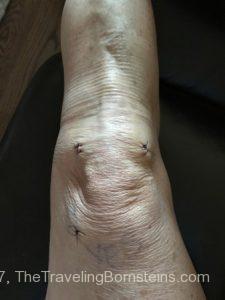A little more than a year after undergoing elective shoulder surgery, I was faced with another surgical decision.

This time around, I was trying to eliminate throbbing knee pain and limitations in my lateral movement. I learned a lesson from my subacromial decompression shoulder surgery. While it’s important to explore all of the conservative measures, at some point I had to decide whether surgery would make the difference.
To avoid shoulder surgery, I worked for two years with doctors and physical therapists. I was optimistic that things would get better even though my quality of life sucked. My active lifestyle was put on pause. I was frustrated.
If you read my original blog— Should I Have Surgery?— and the subsequent blog about rehabbing tips, you know that my story eventually ended on a happy note. I regained full use of my arm and shoulder. I returned to all of my previous activities, including swimming. In retrospect, I should have made the decision sooner.
Now, press the fast forward button and arrive at September 2016. I was walking with my husband on a city street in Victoria, British Columbia when pain radiated through my leg. At first, I ignored it. After all, it was the first day of a four-day birthday trip. The more I walked, the more it throbbed. When we returned to the hotel, I needed multiple ice bags to cover all of the areas that hurt. I persevered. Despite the pain, I found a way to trek on uneven surfaces along the coastline of Vancouver Island. Before leaving Vancouver Island, I called to make an appointment with a Colorado orthopedic doctor.
I was perplexed. I hadn’t done anything out of the ordinary, but I had intense discomfort in my knee as well as other parts of my leg. When I tried to pivot from side to side, it felt like something was stuck inside. If someone stopped abruptly in front of me, a sharp pain shot through my kneecap.
1st Step—Conservative Treatment
After seeking the medical advice of two orthopedic doctors, I consented to a cortisone shot and started physical therapy. The injection took the edge off the pain. At first, the physical therapy relieved some of the discomforts. Then my rehab plateaued. Within a couple of weeks, the overall situation was on a downhill progression. The original pain and limitations returned. Mike Allen, my physical therapist at Steadman Hawkins Sports Physical Therapy and Rehabilitation—Denver, tried everything in his repertoire to improve my situation. The effects of the cortisone shot were wearing off and physical therapy wasn’t working.
For months, I awakened in the middle of the night. I’d hobble to the freezer searching for an ice pack. Ice took an edge off the discomfort. I eventually went back to sleep. Sometimes, I remained awake. I stared at the ceiling. What was I going to do? The pain was around 24/7. I wanted my life back.
2nd Step—Evaluating The Situation When Conservative Treatment Fails
Whenever I need to cope with an orthopedic issue that doesn’t respond to conservative treatment, I evaluate my overall situation by asking three questions:
 Does the situation interrupt my sleep and cause sleep deprivation?
Does the situation interrupt my sleep and cause sleep deprivation?
Do I feel noticeable discomfort almost all the time or just when active?
Does the pain significantly affect my quality of life?
In this case, red flags were flying on all fronts. I was becoming short-tempered due to a lack of sleep. My concentration levels were low. I had trouble writing. I was frustrated because I couldn’t find a way to eliminate the pain. My activity level dropped significantly because I wanted to avoid additional discomfort. I had no choice but to start researching my options.
Controversy Over Surgical Options
Was surgery an effective solution? I didn’t want to put off the inevitable. But at the same time, I didn’t want to undergo surgery unless it was absolutely necessary. Google searches added to my confusion.
I read a MEDLINE abstract about a 2016 study (Exercise Therapy Versus Arthroscopic Partial Meniscectomy For Degenerative Meniscal Tear in Middle-Aged Patients: Randomized controlled trial with Two Year Follow-Up) by Kise, et al. It focused on 140 middle-aged adults who had degenerative medial meniscal tears with no evidence of osteoarthritis. After two years, this randomized controlled study found no difference between the people who had undergone surgery versus the ones that had 12-weeks of supervised exercise therapy.
I also came upon a Canadian study (Arthroscopic Surgery for Degenerative Tears of the Meniscus: a Systematic Review and Meta-analysis) by Khan, et al. This study reviewed MEDLINE databases from 1946 to the beginning of 2014 to determine if there was any benefit to arthroscopic meniscal debridement for degenerative meniscal tears compared to non-operative treatment. Their findings were similar to the 2016 conclusions. But did end with the following statement, “Future research is required to identify how indications and patient selection influence outcomes following surgical and conservative treatment.” Hmm…at least this study was acknowledging that the patients’ background could have an impact on the final outcome.
Numerous other websites discussed the writers’ feelings that arthroscopic knee surgery is based on a false premise. These medical authorities pointed to data that shows that meniscal tears are common in symptom-free mature adults with and without signs of osteoarthritis. Since these people do not experience pain, it’s obvious that all meniscal tears don’t cause pain. However, I didn’t quite grasp how they reached the conclusion that all meniscal tears are pain-free and that something else must be the cause of the patient’s knee pain.
Other sites piggybacked on the above findings and were adamant that a middle-aged person shouldn’t resort to surgery for a medial meniscus tear even though their opinions were based on small studies. It was senseless to undergo any surgical procedure if the situation couldn’t be resolved. I didn’t want to make my situation worse or encounter a surgical complication. But if surgery wasn’t the answer, what else should I consider?
A long time ago, I learned that the internet provides useful as well as inaccurate information. I was going to reserve judgment until I listened to my doctor and possibly a second opinion. Statistics and generalities don’t always apply to everyone. Since I was working with the same doctor who was not in a rush to do shoulder surgery, I felt that he wasn’t a doctor who was eager to perform surgery.
After analyzing my situation, I determined that the negative medical reports and naysayers were irrelevant. Other than the apparent tear, my knee didn’t show any signs of arthritis. The physical therapist and the doctor could find no other issues. My symptoms and an MRI clearly showed the tear. If conservative treatment wasn’t working, I had the choice to either live in pain or have the surgery.
Neither my well-respected doctor, Dr. Thomas Noonan, nor my talented physical therapist, Mike, felt that my knee was responding positively to physical therapy. Nobody was providing much hope that the discomfort would simply disappear over time. If the therapy wasn’t working, it was useless to invest more time and money into physical therapy treatments. I wanted to ski, bike, hike, walk, and continue pursuing my travel career. I scheduled surgery for the beginning of February.
Having Confidence In My Surgeon
I had confidence in my surgeon and his physician assistant, Gary Sakryd. If Dr. Noonan felt that knee surgery would improve my quality of life, I was ready to move forward. Since I had successfully worked with Dr. Noonan and Gary before, I didn’t seek another opinion. There was no need to leave my comfort zone.
Post-Op Recovery

It was the easiest surgery that I’ve ever experienced. I had minimal swelling, negligible discomfort, and no bruising. To maintain the status quo, I iced on and off during the day and used an ice machine at night. Within a day or two, I was off crutches and walking one foot at a time up and downstairs within 1-2 weeks. After three weeks, my knee no longer kept me up at night. About five weeks post-op, I was on a plane headed to Mumbai, India.
I realize that each surgery presents a new set of factors. Fortunately, I had a much easier time than I anticipated. The recovery from two previous meniscus surgeries was longer and considerably more challenging.
Post-op, Dr. Noonan pointed out where he debrided a complex tear of the posterior horn of the meniscus and addressed a minor lateral tear. He stated that it would have been an unwise decision to ski without addressing these tears. Months later, I’m happy that I went ahead with the surgery. My daily activities and exercise routine work toward strengthening the leg. I look forward to skiing at the end of this year
Concluding Thoughts
Individuals need to approach their meniscus tears based on their own past, and current history as well as their lifestyle. Before consenting to the surgery, I discussed what I had read online. Dr. Noonan did not feel that the medical studies applied to my situation. I had no reason to doubt his evaluation. A competent orthopedic surgeon should be able to make the appropriate diagnosis and determine an individualized treatment plan. If you have any doubts or concerns, it’s always wise to seek one or more additional opinions.
While the recovery time for my first two knee surgeries was longer, I eventually regained my leg strength and the joint’s full range of motion. I could only hope that my outcome would be similar this time around.
Will this be a temporary fix? I don’t know. I never anticipated that the surgery on my right knee would fail after 12 years while the left knee is fine after 24 years. Traumatic events—ski and car accidents caused these tears. When I asked the surgeon the likelihood of a future tear, he said it was too hard to predict. In all fairness, there is no way for any doctor to know how my knee will respond to an active boomer lifestyle or the unpredictable variables that are part of life.
After just a few weeks post-op, I knew that I had made the right decision. The discomfort level was a fraction of what it had been prior to the surgery and the knee no longer throbbed in the middle of the night. I was thrilled. The medial meniscal arthroscopic surgery addressed the tears and removed my pain.
Should I attribute my pain-free state to the placebo effect that Seth Godin gleefully wrote about last month? In his blog post, Sham Surgery, he refers to a 2014 review that is mentioned in the article, Surgery Is One Hell of A Placebo. Christie Aschwanden discusses the outcomes associated with sham surgeries. These peculiar studies compare elective surgical procedures to sham surgeries. It’s unclear what type of people would consent to undergo a fake surgery for the sake of scientific research. While the data suggests that invasive surgical procedures can cause a strong placebo effect, I don’t believe that these studies should stop anyone from consenting to a real surgical procedure to address a diagnosed issue.
I find it illogical that the part of the tear that was getting stuck in my knee and limiting my range of motion would have healed on its own without surgical intervention. My exceptionally competent physical therapist, Mike, tried everything he could to eliminate my discomfort and improve my mobility. However, I do agree with Seth Godin that the placebo effect should make people think twice before starting medication or consenting to a surgical procedure. However, I don’t feel that the placebo effect can always remedy a medical problem.
I reaffirm what I stated in 2015—
I encourage anyone who is procrastinating surgery, to consider their options and overcome their fears. While surgery cannot solve all medical issues, in many cases it can relieve chronic pain and improve a person’s quality of life.
I send my best wished to anyone who is contemplating or has recently undergone meniscus knee arthroscopic surgery.
Can You Share?
Can you share your medial meniscus physical therapy, alternative therapy, or a surgical story?
Related Posts
Active Lifestyles Versus the Aging Process
Tips for Handling Multiple Doctors’ Opinions
Overcoming a Physical Therapy Setback
Tips for Traveling With Crutches
10 Tips for Foot Surgery Post-Op Recovery
10 Tips for Subacromial Decompression Post-Op Recovery
Meaningful Anniversary (hip replacement)
5 Ways to Improve Exercise Motivation
Confronting an Irrational Fear
BIO
Sandra Bornstein is a freelance travel and lifestyle writer. She shares her experiences and recommendations on this blog and on other websites. She also has a secondary website, TheTravelingBornsteins that exclusively focuses on travel. See https://thetravelingbornsteins.com. Sandra contributes a monthly travel tip column for Golden Living, a Best Version Media magazine.
Sandra is the author of MAY THIS BE THE BEST YEAR OF YOUR LIFE. This memoir highlights Sandra’s living and teaching adventure in Bangalore, India. As a licensed Colorado teacher, Sandra has taught K-12 students in the United States and abroad. She also taught college level courses.
Sandra’s memoir was a finalist in the Travel category for the 2013 Next Generation Indie Book Awards, the 2013 International Book Awards, the 2013 National Indie Book Excellence Awards, 2013 USA Best Book Awards, and a Honorable Mention award in the Multicultural Non-Fiction category for the 2013 Global ebook Awards.
THANK YOU so much for this article. I am a middle-aged woman who has been struggling the past number of months with multiple knee issues, including a posterior horn meniscal tear.
I, too, have found the strongly-opinionated attitudes of the “against” group with their comments about the placebo effect perplexing.
Thank you for the ray of hope.
Lisa,
I sincerely hope you find a way to solve your painful knee issues. I’m happy that I followed my gut decision to have surgery. While it’s hard to predict what the future will bring, for the time being I’m able to do everything I want without any pain. I realize that surgery is not the only option. In my case, conservative treatments failed to resolve the problem. I was lucky that surgery improved my situation.